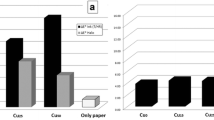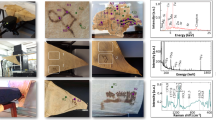Abstract
A minimally invasive approach is described for sampling Fe, Cu, Zn and Mn in iron-gall ink. Filter paper (2 × 5 mm) that is moistened with de-ionized water is used to extract metals from an iron-gall ink surface. The extraction requires about 30–120 s for a small quantity of ink to diffuse into the moistened filter paper. The metals in the ink are extracted from the filter paper using 50 µL of concentrated nitric acid in a 2 mL polystyrene beaker for approximately 10 min. Graphite furnace atomic absorption spectrometry (GFAAS) was used to quantify Fe, Cu, Zn and Mn in iron-gall ink. In order to test the feasibility of this extraction procedure, the ratio of Fe:Cu was determined from ink lines that were drawn with a commercially available iron-gall ink on modern acid-free paper. The measured ratio of Fe:Cu was 18.2:1 which is comparable to the expected ratio of 20:1. The slightly lower ratio achieved using the extraction procedure and GFAAS was possibly due to the higher solubility of the Cu species in the ink. One of the advantages of using a moistened filter paper is that only the ink surface is sampled which avoids the possible measurement of metals of different inks of other components that may be present in the paper or on the opposite side of the paper.




Similar content being viewed by others
References
Neeval J (1995) Phytate—a potential conservation agent for the treatment of ink corrosion caused by iron-gall inks. Restaurator 16:143–160
The Ink Corrosion Website http://www.knaw.nl/ecpa/ink
Potthast A, Henniges U, Banik G (2008) Iron-gall ink-induced corrosion of cellulose: aging, degradation and stabilization. Part 1: model paper studies. Cellulose 15:849–859
Henniges U, Reibke R, Banik G, Huhsmann E, Hahner U, Prohaska T, Potthast A (2008) Iron-gall ink-induced corrosion of cellulose: aging, degradation and stabilization. Part 2: application on historic sample material. Cellulose 15:861–870
Kolar J, Stolfa A, Strilic M, Pompe M, Pihlar B, Budnar M, Simcic J, Reissland B (2006) Historical iron-gall ink containing documents—properties affecting their condition. Analytical Chemica Acta 555:167–174
Rouchon-Quillet V, Remazeilles C, Bernard J, Wattiaux A, Fournes L (2004) The impact of gallic acid on iron-gall ink corrosion. Appl Phys A Mater Sci & Process 79:389–392
Hahn O, Malzer W, Kanngiesser B, Beckhoff B (2004) Characterization of iron-gall inks in historical manuscripts and music compositions using X-ray fluorescence spectrometry. X-ray Spectrom 33:234–239
Aceto M, Agostino A, Boccaleri E, Garlanda AC (2008) The Vercelli Gospels laid open: an investigation into the inks used to write the oldest Gospels in Latin. X-ray Spectrom 37:286–292
Bicchieri M, Monti M, Piantanida G, Sodo A (2008) All that is iron-ink is not always iron-gall! J Raman Spectrosc 39:1074–1078
Wagner B, Bulska E, Hulanicki A, Heck M, Ortner HM (2001) Topochemical investigation of ancient manuscripts. Fresenius J Anal Chem 369:674–679
Virro K, Mellikov E, Volobujeva O, Sammelselg V, Asari J, Paama L, Jurgens J, Leito I (2008) Estimation of uncertainty in electron probe microanalysis: iron determination in manuscripts, a case study. Microchimica Acta 162:313–323
Budnar M, Ursic M, Simcic J, Pelicon P, Kolar J, Selih VS, Strlic M (2006) Analysis of iron-gall inks by PIXE. Nucl Instrum & Meth Phys Res B—Beam Interact Mater Atoms 243:407–416
Budnar M, Simcic J, Rupnik Z, Ursic M, Pelicon P, Kolar J, Strlic M (2004) In-air PIXE set-up for automatic analysis of historical document inks. Nucl Instrum & Meth Phys Res B—Beam Interact Mater Atoms 219:41–47
Budnar M, Vodopivec J, Mando PA, Casu FLG, Signorini O (2001) Distribution of chemical elements of iron-gall ink writing studied by the PIXE method. Restaurator Int J Preservation Libr Arch Mater 22:228–241
Lucarelli F, Mando PA (1996) Recent applications to the study of ancient inks with the Florence external-PIXE facility. Nucl Instrum & Meth Phys Res B—Beam Interact Mater Atoms 109:644–652
Cambria R, Delcarmine P, Grange M, Lucarelli F, Mando PA (1993) A Methodological test of external beam PIXE analysis on inks of ancient manuscripts. Nucl Instrum & Meth Phys Res B—Beam Interact Mater Atoms 75:488–492
Wagner B, Bulska E, Meisel T, Wegscheider W (2001) Use of atomic spectrometry for the investigation of ancient manuscripts. J Anal At Spectrom 16:417–420
Wagner B, Bulska E (2004) On the use of laser ablation inductively coupled plasma mass spectrometry for the investigation of the written heritage. J Anal At Spectrom 19:1325–1329
Neevel JG, Reissland B (2005) Bathophenanthroline indicator paper. Papier Restaurierung 6(1):28–36
Neevel JG (2009) Application issues of the bathophenanthroline test for iron(II) ions. Restaurator 30:3–15
Vuori J, Tse S (2005) A preliminary study of the use of bathophenanthroline iron test strips on textiles, In Preprint of ICOM 14th Triennial Meeting, Vol. II, The Hague, Netherlands, 12–16 September 2005, ed. J. Bridgland, 898–995
Civici N (2006) Non-destructive identification of inorganic pigments used in 16–17th century Albanian icons by total reflection X-ray fluorescence analysis. J Cult Herit 7:339–343
Civici N, Demko O, Clark RJH (2005) Identification of pigments used on late 17th century Albanian icons by total reflection X-ray fluorescence and Raman microscopy. J Cult Herit 6:157–164
Wehling B, Vandenabeele P, Moens L, Klockenkamper R, von Bohlen A, Van Hooydonk G, de Reu M (1999) Investigation of pigments in medieval manuscripts by micro Raman spectroscopy and total reflection X-ray fluorescence spectrometry. Mikrochim Acta 130:253–260
Vandenabeele P, Wehling B, Moens L, Dekeyzer B, Cardon B, von Bohlen A, Klockenkamper R (1999) Pigment investigation of a late-medieval manuscript with total reflection X-ray fluorescence and micro-Raman spectroscopy. Analyst 124:169–172
Van Hooydonk G, De Reu M, Moens L, Van Aelst J, Milis L (1998) A TXRF and micro-Raman spectrometric reconstruction of palettes for distinguishing between scriptoria of related medieval manuscripts. Eur J Inorg Chem 1998:639–644
Goltz DM, Charleton K, Cloutis E, Grinberg P, Collins C (2007) Identification of darkened pigments in cultural objects by graphite furnace atomic absorption spectroscopy and inductively coupled plasma-mass spectrometry. J Anal At Spectrom 22:140–146
Goltz DM, Coombs J, Marion C, Cloutis E, Gibson J, Attas M, Choo-Smith LP, Collins C (2004) Pigment identification in artwork using graphite furnace atomic absorption spectrometry. Talanta 63:609–616
Liang L, D’Haese PC, Larnberts LV, De Broe ME (1989) Direct Determination of iron in urine and serum using graphite furnace atomic absorption spectrometry. Analyst 114:143–147
Akman S, Doner G (1994) Interference mechanisms of sodium chloride on zinc and cobalt in graphite furnace atomic absorption spectrometry using a dual cavity platform. Spectrochim Acta 49B:665–675
Acknowledgements
Funding for this research was provided by the Natural Sciences and Engineering Research Council of Canada (NSERC) and the University of Winnipeg. R. Hiebert acknowledges NSERC for an undergraduate summer research award. The authors also gratefully acknowledge Diane Haglund (United Church of Canada Archives) and Gabrielle Prefontaine (University of Winnipeg Rare Book Collection) for access to ink samples and useful discussions on iron-gall ink.
Author information
Authors and Affiliations
Corresponding author
Rights and permissions
About this article
Cite this article
Goltz, D., Chin, J., Hiebert, R. et al. Micro-extraction and determination of transition metals in historical ink. Microchim Acta 170, 127–133 (2010). https://doi.org/10.1007/s00604-010-0375-4
Received:
Accepted:
Published:
Issue Date:
DOI: https://doi.org/10.1007/s00604-010-0375-4




